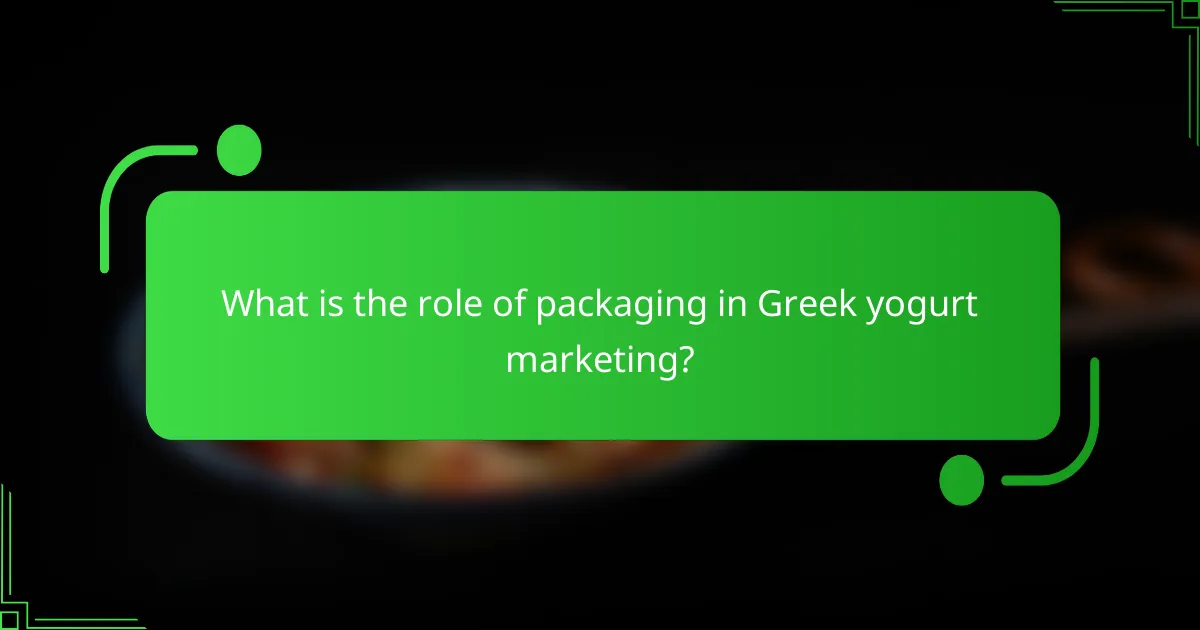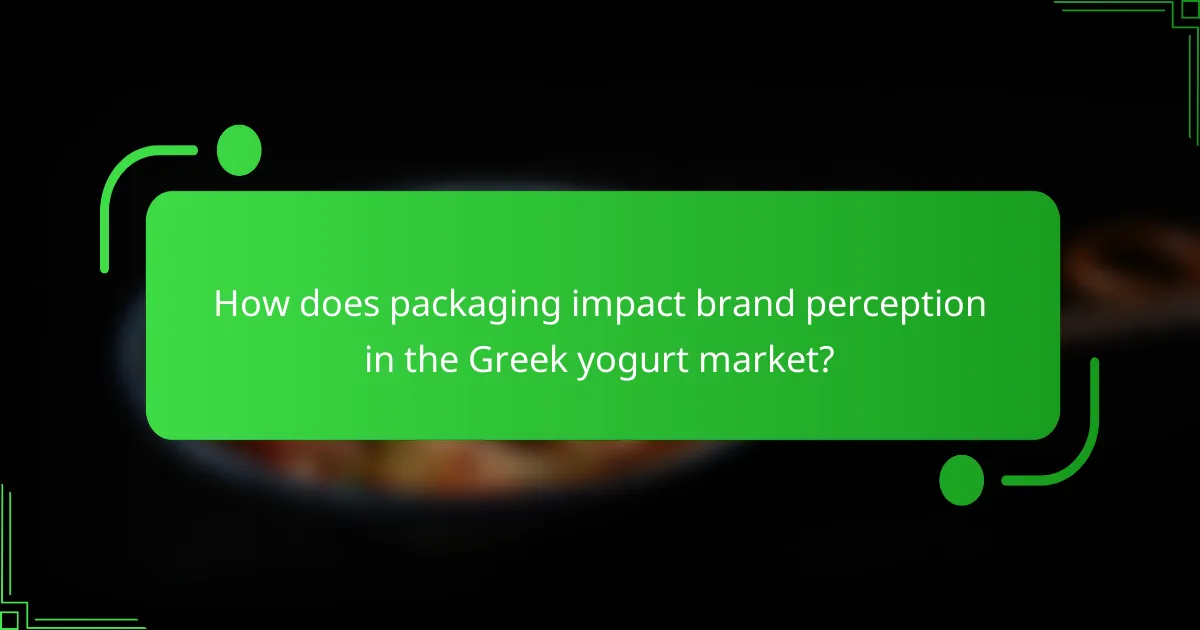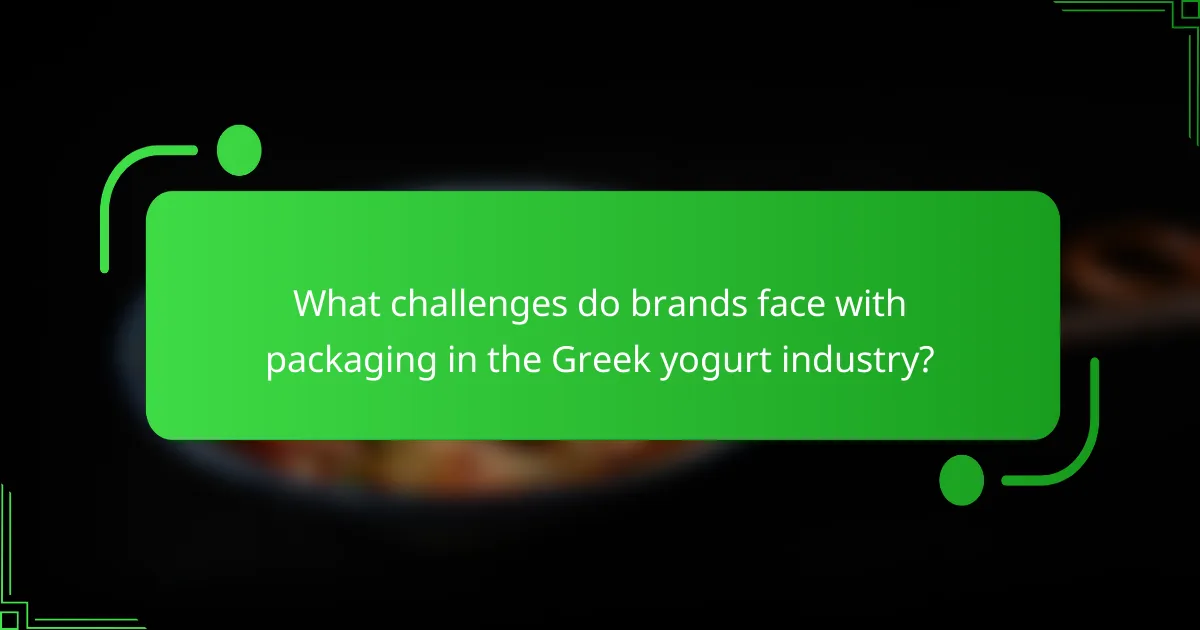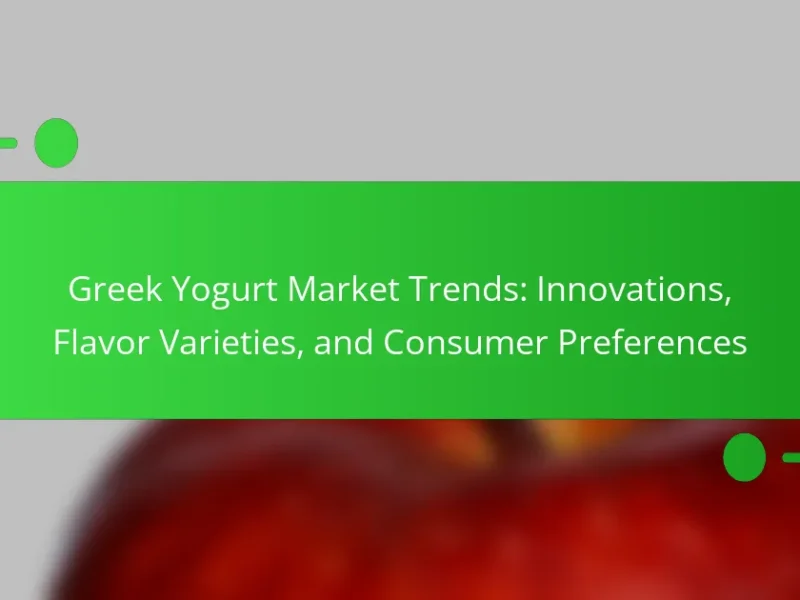Packaging is a critical factor in the marketing of Greek yogurt, influencing consumer perception and purchase decisions. It serves as the initial interaction point between the product and consumers, with attractive designs enhancing brand visibility and perceived quality. Clear labeling communicates essential product attributes, while sustainable packaging caters to the growing demand for eco-friendly options. Research indicates that effective packaging strategies can significantly boost brand loyalty and sales growth, despite challenges such as ensuring product freshness, balancing functionality with sustainability, and navigating regulatory compliance. Unique packaging designs are essential for differentiation in a competitive market, highlighting the importance of strategic planning in packaging decisions.

What is the role of packaging in Greek yogurt marketing?
Packaging plays a crucial role in Greek yogurt marketing by influencing consumer perception and purchase decisions. It serves as the first point of contact between the product and the consumer. Attractive packaging can enhance brand visibility on shelves. Clear labeling communicates product attributes, such as health benefits and ingredients. Sustainable packaging appeals to environmentally conscious consumers. Research shows that 70% of consumers are more likely to buy products with eco-friendly packaging. Additionally, unique designs can differentiate brands in a competitive market. Overall, effective packaging strategies contribute to brand loyalty and sales growth.
How does packaging design influence consumer perception of Greek yogurt?
Packaging design significantly influences consumer perception of Greek yogurt. Effective packaging attracts attention and conveys quality. Bright colors and appealing graphics can create a positive first impression. Clear labeling of nutritional information enhances trust and transparency. Unique shapes or materials can differentiate a brand from competitors. Research shows that consumers often associate premium packaging with higher product quality. Additionally, sustainable packaging can appeal to environmentally conscious consumers. Overall, packaging design plays a crucial role in shaping consumer attitudes and purchasing decisions in the Greek yogurt market.
What elements of packaging design are most impactful on consumer choices?
The most impactful elements of packaging design on consumer choices include color, typography, and imagery. Color influences consumer emotions and perceptions. Research shows that up to 90% of snap judgments about products are based on color alone. Typography affects readability and brand recognition. Clear and attractive fonts can enhance the overall appeal of the packaging. Imagery, including graphics and images, communicates product benefits and quality. Effective imagery can increase purchase intent significantly. Additionally, sustainability in packaging is increasingly important. Studies indicate that 66% of consumers prefer brands that use environmentally friendly packaging. These elements collectively shape consumer preferences and drive purchasing decisions in the market.
How do color and graphics on packaging affect brand recognition?
Color and graphics on packaging significantly enhance brand recognition. They create visual associations that consumers remember. Research shows that color can increase brand recognition by up to 80%. Graphics help convey brand identity and values effectively. For instance, vibrant colors can attract attention and evoke emotions. Consistent use of specific colors helps establish a brand’s identity over time. Studies indicate that people make judgments about products within 90 seconds based on packaging alone. Therefore, effective use of color and graphics is crucial for brands, especially in competitive markets like Greek yogurt.
Why is sustainability important in Greek yogurt packaging?
Sustainability is important in Greek yogurt packaging because it reduces environmental impact. Sustainable packaging minimizes waste and lowers carbon emissions during production and disposal. Many consumers prefer eco-friendly products. Research shows that 66% of global consumers are willing to pay more for sustainable brands. Using recyclable or biodegradable materials enhances brand reputation. Sustainable packaging also aligns with health-conscious consumer values. Brands that prioritize sustainability can improve customer loyalty and market share.
What sustainable materials are commonly used in Greek yogurt packaging?
Common sustainable materials used in Greek yogurt packaging include recycled paper, biodegradable plastics, and glass. Recycled paper is often utilized for labels and outer packaging. Biodegradable plastics, such as PLA (polylactic acid), are increasingly used for containers. Glass is a highly recyclable material that maintains product integrity. These materials help reduce environmental impact while appealing to eco-conscious consumers. According to a study by the European Commission, packaging made from recycled materials can significantly lower carbon emissions.
How does sustainability in packaging affect consumer purchasing decisions?
Sustainability in packaging significantly influences consumer purchasing decisions. Consumers increasingly prefer products with eco-friendly packaging. A study by Nielsen found that 73% of global consumers are willing to change their consumption habits to reduce environmental impact. This preference is evident in the food industry, including Greek yogurt. Brands that adopt sustainable packaging often see improved customer loyalty and brand perception. Research indicates that 66% of consumers consider sustainability when making purchasing choices. Thus, sustainable packaging can lead to increased sales and a competitive advantage in the market.

How does packaging impact brand perception in the Greek yogurt market?
Packaging significantly impacts brand perception in the Greek yogurt market. It serves as the first point of interaction between consumers and the product. Attractive packaging can enhance perceived quality, influencing purchasing decisions. Research from the Journal of Consumer Research indicates that visual elements in packaging can evoke emotional responses. Sustainable packaging also positively affects brand image, appealing to environmentally conscious consumers. A study by Nielsen found that 66% of global consumers are willing to pay more for sustainable brands. Therefore, effective packaging design is crucial for differentiating brands in a competitive market.
What are the key attributes consumers associate with well-packaged Greek yogurt?
Key attributes consumers associate with well-packaged Greek yogurt include freshness, convenience, and sustainability. Freshness is often indicated by clear labeling and transparent packaging. Convenience is reflected in easy-to-open designs and portion sizes. Sustainability is highlighted through recyclable materials and eco-friendly production practices. These attributes enhance consumer trust and brand loyalty. Research shows that 75% of consumers prefer brands that use sustainable packaging. This preference influences purchasing decisions significantly.
How does packaging communicate brand values to consumers?
Packaging communicates brand values to consumers through design elements, materials, and messaging. The visual design of packaging reflects the brand’s identity and aesthetic. Colors, fonts, and imagery create an emotional connection with consumers. Sustainable materials signal a commitment to environmental responsibility. Clear labeling of ingredients and nutritional information builds trust and transparency. Packaging also conveys quality through its sturdiness and functionality. Studies show that 72% of consumers believe packaging design influences their purchasing decisions. Effective packaging can differentiate a brand in a crowded market, reinforcing its unique values.
What role does packaging play in differentiating Greek yogurt brands?
Packaging plays a crucial role in differentiating Greek yogurt brands. It serves as the first point of interaction with consumers. Effective packaging communicates brand identity and product quality. Unique designs can attract attention on store shelves. Color schemes and graphics convey flavor and health benefits. Sustainable packaging options appeal to environmentally conscious consumers. Packaging also provides essential information, such as nutritional content and ingredients. Research indicates that 70% of purchasing decisions are influenced by packaging design. Thus, packaging significantly impacts brand perception and consumer choices in the Greek yogurt market.
How can brands leverage packaging to enhance marketing strategies?
Brands can leverage packaging to enhance marketing strategies by creating visually appealing designs that attract consumers. Effective packaging communicates brand values and product benefits. For example, sustainable packaging can appeal to environmentally conscious consumers. Research shows that 72% of consumers prefer brands that use eco-friendly packaging. Additionally, unique packaging shapes can differentiate products on shelves. This differentiation can lead to increased brand recognition. Engaging packaging can also encourage social media sharing, amplifying brand visibility. Overall, strategic packaging choices can significantly influence consumer purchasing decisions.
What innovative packaging solutions are currently trending in the Greek yogurt market?
Innovative packaging solutions trending in the Greek yogurt market include eco-friendly materials and single-serve containers. Brands are increasingly using biodegradable and recyclable packaging to appeal to environmentally conscious consumers. Flexible pouches are gaining popularity for their lightweight and space-saving benefits. Additionally, smart packaging technology is being introduced, allowing for freshness tracking. Attractive designs and vibrant colors are also being utilized to enhance shelf appeal. These trends reflect the industry’s focus on sustainability and consumer convenience.
How can brands measure the effectiveness of their packaging in marketing campaigns?
Brands can measure the effectiveness of their packaging in marketing campaigns through several methods. These include consumer surveys, sales data analysis, and A/B testing. Consumer surveys can provide insights into customer perceptions and preferences regarding packaging design. Sales data analysis helps identify correlations between packaging changes and sales performance. A/B testing involves comparing two packaging designs to see which performs better in real-world settings. Research shows that effective packaging can increase purchase intent by up to 30%. By combining these methods, brands can gain a comprehensive understanding of packaging effectiveness.

What challenges do brands face with packaging in the Greek yogurt industry?
Brands in the Greek yogurt industry face several challenges with packaging. One major challenge is ensuring product freshness and shelf life. Greek yogurt requires airtight packaging to maintain its quality. Another challenge is sustainability; consumers increasingly prefer eco-friendly materials. Brands must balance functionality with environmental impact. Cost is also a significant factor; high-quality packaging can increase production expenses. Additionally, differentiation in a crowded market is crucial. Unique packaging designs help brands stand out but can be costly to develop. Finally, compliance with regulations regarding labeling and safety adds complexity to packaging decisions. These challenges require strategic planning to effectively address consumer needs and market demands.
What are the common pitfalls in Greek yogurt packaging design?
Common pitfalls in Greek yogurt packaging design include unclear labeling, inadequate information, and poor sustainability practices. Unclear labeling can confuse consumers about product ingredients and nutritional benefits. Inadequate information may lead to missed opportunities for highlighting unique attributes, such as probiotic content or sourcing. Poor sustainability practices can alienate environmentally conscious consumers. Additionally, overly complex designs can detract from brand identity and consumer recognition. Research indicates that packaging should balance aesthetics with functionality to enhance consumer engagement.
How can brands overcome sustainability challenges in packaging?
Brands can overcome sustainability challenges in packaging by adopting eco-friendly materials. Utilizing biodegradable or recyclable materials reduces environmental impact. Implementing minimalistic packaging designs can also decrease waste. Brands should invest in sustainable sourcing practices for raw materials. Collaborating with suppliers who prioritize sustainability enhances the overall supply chain. Educating consumers about proper disposal methods promotes recycling. Conducting life cycle assessments can help brands identify improvement areas. Research shows that 66% of consumers are willing to pay more for sustainable products.
What regulations impact packaging choices in the Greek yogurt market?
Regulations impacting packaging choices in the Greek yogurt market include food safety standards and environmental regulations. The European Union mandates compliance with food packaging safety regulations, ensuring materials do not contaminate products. Additionally, the EU’s Packaging and Packaging Waste Directive requires manufacturers to minimize waste and promote recyclability. These regulations influence packaging materials and designs used in the Greek yogurt industry. Compliance with these standards is essential for market access and consumer trust.
What best practices should brands follow for effective Greek yogurt packaging?
Brands should prioritize clarity and transparency in Greek yogurt packaging. Clear labeling helps consumers understand the product’s ingredients and nutritional value. Brands should also use visually appealing designs to attract attention. Research shows that attractive packaging increases purchase likelihood by 30%. Sustainable materials are essential for modern consumers. Eco-friendly packaging resonates with 72% of shoppers who prefer sustainable products. Additionally, resealable options enhance convenience for consumers. Convenience features can lead to a 25% increase in repeat purchases. Lastly, incorporating brand storytelling on packaging can create emotional connections. Emotional branding can boost customer loyalty by 20%.
How can brands ensure their packaging aligns with consumer expectations?
Brands can ensure their packaging aligns with consumer expectations by conducting thorough market research. Understanding consumer preferences is crucial. Surveys and focus groups can reveal insights into desired packaging features. Brands should also analyze competitor packaging to identify industry standards. Sustainability is increasingly important; consumers prefer eco-friendly materials. Clear labeling of nutritional information meets consumer demand for transparency. Engaging design can attract attention and communicate brand values effectively. Testing packaging prototypes with target audiences can provide valuable feedback. Regularly updating packaging based on consumer trends can maintain relevance in the market.
What tips can brands implement to enhance the appeal of their Greek yogurt packaging?
Brands can enhance the appeal of their Greek yogurt packaging by focusing on design, sustainability, and consumer engagement. Eye-catching graphics and vibrant colors attract attention on shelves. Clear labeling of nutritional benefits informs consumers about health advantages. Eco-friendly materials resonate with environmentally conscious shoppers. Unique container shapes can differentiate products from competitors. Interactive packaging, such as QR codes, can provide additional product information. Limited edition designs can create urgency and exclusivity. Incorporating transparent sections allows consumers to see the product inside, building trust. Research shows that attractive packaging can increase sales by up to 30%.
The main entity of this article is packaging in the context of Greek yogurt marketing. The article examines the critical role packaging plays in influencing consumer perception, purchase decisions, and brand differentiation. Key topics include the impact of design elements such as color, typography, and imagery on consumer choices, the importance of sustainability in packaging materials, and how effective packaging strategies can enhance brand loyalty and sales growth. Additionally, it addresses challenges brands face in packaging design, including compliance with regulations and the need for clear labeling to communicate product attributes effectively.


